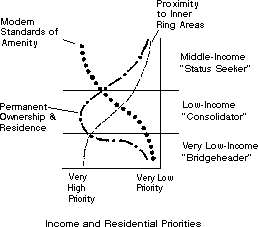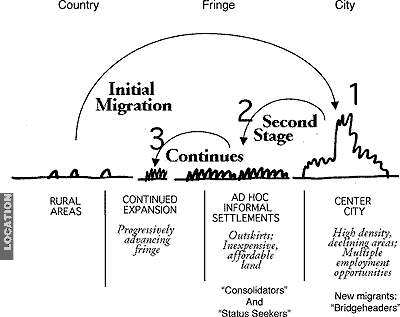Summary and excerpts from:
Housing Priorities, Settlement Patterns, and Urban Development in Modernizing Countries. Turner, John F.C. November 1968. AIP Journal. Pp 354-363.
Attempts to plan the development in cities of developing countries and to improve the housing standards are often confounded by the autonomous action of low-income squatters and clandestine developers. A model of the settlement process in transitional countries shows the interrelated dynamics that take place in the urban settlement process and the importance of the qualitative dwelling environment.
Housing should be defined in terms of the dwelling environment and not the dwelling structures. The value is in the relationship between man and environment, not simply the physical conditions. A ‘good’ environment is not necessarily one of high physical standards; if the inhabitant wants to save money to send his children to school, a poor but cheap house will be better than an expensive one of high material standards that would ruin the family’s long-term expectations. Similarly, a young, unskilled migrant will be primarily concerned with getting himself a job and, through it, an urban skill and income that will enable him and his present (or future) family to live tolerably well. A very cheap bedspace or, if he has a family, a rented room in a run-down tenement would be far more appropriate that a modern standard dwelling that would absorb an impossibly high proportion of his income. Even when subsidized modern dwellings are available, they generally tie the family to a specific peripheral location that increases expenditures and reduces job opportunities. Unlike the mortgaged house, the rented room can be given up with very short notice, and the occupier is free to move quickly to another location. Overcrowding, discomfort, and even the usually avoidable filth of the slum may be a price the aspirant to better living standards is quite willing to pay for improved opportunities.
Dwelling environments are assumed to provide three basic functions: location, tenure, and amenity. For any place to function as a dwelling it must have an accessible location, it must provide secure, continued residence for a minimum period, and it must provide a minimum of shelter from hostile elements - whether climatic or social. These functions vary according to the social situations: the momentary positions people occupy on their chosen trajectories.
Tenure and Social Security
There is a difference between the very poor and insecure and the more regularly employed upper-lower and lower-middle income groups. Institutionalized social security is a privilege reserved for the elite in transitional societies- the most highly skilled workers and other employees of certain modern industrial concerns, government employees, and the small middle class. Urban home ownership provides at least a partial alternative source of social and economic security. Even if the dwelling is no more than a shack on a plot of rough land, it frees the owner from rent payment; it also provides him with the opportunities for additional income and the chance to invest his small savings, skills, and spare time. Often families deliberately build their houses as duplex apartments- one apartment for themselves, the other for rent or for the occupation by the second generation who will be on hand to assist the parents in their old age.
Income and Housing Priorities
Three social situations are identified which roughly parallel income: the lowest income is the ‘bridgeheader’ seeking a toehold in the urban system. The second is the ‘consolidator’ who has obtained a relatively firm hold but is in danger of losing it unless he can consolidate his newly achieved socioeconomic status. The third level is the higher income ‘status seeker’. These three can be compared to their priority of location, ownership, and amenity, rated accordingly from essential to disadvantageous.

The bridgeheader has very high priority to employment location, generally found in city centers with its ample casual opportunities for the unskilled and conversely very low priority to high standards of amenities and permanent ownership. The low-income consolidator has very high priority to ownership, declining priorities for the center city, and shares a low priority for amenities with the bridgeheader. Conversely the middle-income status seeker places high value on amenities and very low value on permanent ownership and proximity to city center.

Generalized Trajectory of Immigration
Relation to Urban Settlement
The pattern can be seen as the product of the needs for location, tenure, and amenity combined with the means for their satisfaction. Location will be determined by minimum subsistence costs in the case of the poorest, and in the upward striving consolidator, location will be determined by the cost of owner-occupied land and construction if the dwelling plays a primary social security role.
The Early Transitional City: Immigration is on a small scale and city growth is relatively slow. There are few consolidators, the job market is not yet flooded and paternalist, semifeudal relationships persist. The very poor who ‘make it’ into the ranks of the artisan or petty commercial class will generally rent a dwelling, often a subdivided portion of a large town house vacated by an upper income family.
The Midtransitional City: In the most rapidly urbanizing phase of development, which appears to coincide with a rapidly raising but still low level of industrial investment, the greater part of the employed low-income population is composed of migrants from smaller towns and cities. The bridgeheaders tend to concentrate in the central, inner ring areas where subsistence living costs are lowest and there are the highest concentrations of employment opportunities and urban services.
The Late Transitional City: Mexico City is probably in this phase. Often the inner ring shantytowns are fewer and no longer provide cheap, temporary accommodations for the very poor. They themselves are approaching stable communities. The inhabitants pay very low rents that more than compensate for the often unsanitary conditions and overcrowding. As national productivity and personal incomes rise and as national institutions develop- especially those providing credit and social security-the pressures for squatting naturally decreases. With higher incomes, the regularly employed will be less willing to accept the very low initial standards of the squatter ‘consolidation settlements’.
A Service Approach
Successful urban planning and low-income housing policies in transitional contexts depend on the alignment of government action with the priorities and forces of popular settlement. This implies giving a much lower priority than is customary to the promotion of housing units and the development of the inevitably cumbersome government institutions set for this purpose. It implies the abandonment of the project approach to urban development and the substitution of the service approach.
|


